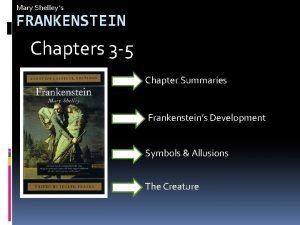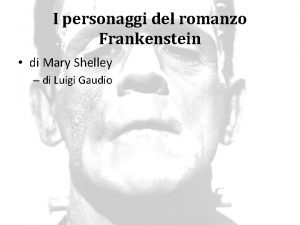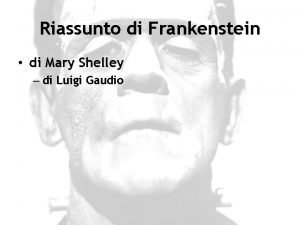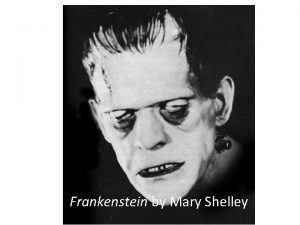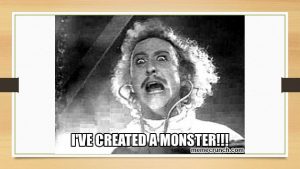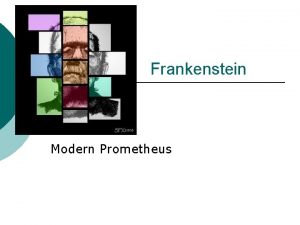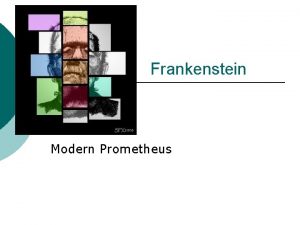Mary Shelley 1797 1851 FRANKENSTEIN or The modern









- Slides: 9

Mary Shelley (1797 -1851) FRANKENSTEIN or The modern Prometheus (1818)

Mary Shelley’s life • Mary Shelley (1797 -1851) was the daughter of Mary Wollstonecraft, a writer and forerunner of the feminist movement, and William Godwin, a philosopher and writer. She had showed literary talent since she was a child. • In 1812 she met Percy Shelley. He was married, but they escaped together. • At the age of 19, she wrote Frankenstein. • When his wife committed suicide in 1816, they got married. They lived in Switzerland for a while and then in Italy with their son. • In 1822 Percy Shelley died while sailing; Mary returned to England wrote novels to live. She died in 1851.

The origin of Frankenstein In 1816 Percy and Mary Shelley lived with lord Byron and the physician W. Polidori at Lake Geneva. One evening, Byron suggested to write a ghost story. Mary wrote this story inspired by a nightmare she had that night. But she didn’t complete it until they left Switzerland.

Frankenstein: a combination of voices The story is set at the end of the 18 th century. It is told by 3 different narrators: 1) Robert Walton, an explorer going to the North Pole 2) Victor Frankenstein, a scientist who wanted to know the secret to create life 3) The monster, Frankenstein’s creation. The story is written in the form of LETTERS, that Walton wrote to his sister and go back to the Monster’s creation, Frankenstein’s abandon and many deaths; but we also find letters, notes, journals which document the monster’s emotions.

The Plot • The story starts with Captain Robert Walton writing a letter to his sister. During a voyage to the North Pole, the crew saves a man from the water: it is doctor Victor Frankenstein. • He tells his story: he was obsessed with studies about natural wonders and finds the secret to give life to non-living matter. • He creates a humanoid who is very tall, has watery eyes and yellow skin. He is afraid and escapes. When he comes back, the monster has escaped.

The Plot (2) • After the trauma of this experience, Victor stays 4 months in recovery at the hospital. When he leaves the hospital, he finds out his brother has been killed and sees the monster on the crime place. • The monster asks Victor to hear his story; so, from this moment on, it is the monster who speaks. • The monster tells that everybody was afraid of him and his experience in trying to approach a family living in a cottage where he had lived.

The Plot (3) • So he asks Victor to create a female companion for him. If Victor doesn’t accept, the Creature will kill all his friends and loved ones. • Victor is afraid of creating another creature, so he doesn’t finish it. When the Monster sees it, he kills his friend and blames Victor. Then, he also kills Victor’s wife on their first wedding night. • Victor follows the Creature up to the North Pole, but he dies. • Captain Walton reconstructs the story.

The Themes • Frankenstein is not only a GOTHIC NOVEL (horror elements and setting), but also an early example of SCIENCE FICTION. • The main theme is Frankenstein’s PURSUIT OF KNOWLEDGE: he tries to go beyond human limits but this only brings death and destruction. It is similar to Faust, who sold his soul to the Mephistopheles to have knowledge, but also to PROMETHEUS (in fact the book’s subtitle is The Modern Prometheus), the figure in Greek mythology who stole Zeus’s fire: humans benefited from it, but he was chained to a rock forever. In fact Frankenstein is punished for what he did.

The Themes • Another important theme is NEGLECT (abbandono) and DEVELOPMENT: the huge monster is rejected by everybody, especially his creator (that he calls ‘father’) and is like a neglected child. He has to grow up alone and educate himself. • The novel is the description of the monster’s development. The creature realizes that a child without parents becomes a monster. He says that he was born good but was obliged by the others to become evil.
 Theme of frankenstein mary shelley
Theme of frankenstein mary shelley Chapter summaries of frankenstein
Chapter summaries of frankenstein Symbols in frankenstein
Symbols in frankenstein Literary devices in frankenstein letters 1-4
Literary devices in frankenstein letters 1-4 Mary shelley frankenstein biography
Mary shelley frankenstein biography Personaggi frankenstein
Personaggi frankenstein Frankenstein ch 18 summary
Frankenstein ch 18 summary Frankenstein di mary shelley riassunto
Frankenstein di mary shelley riassunto Mary shelley frankenstein summary
Mary shelley frankenstein summary Eli whitney cotton gin
Eli whitney cotton gin

